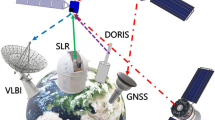Abstract
It is important to make accurate and precise measurements in surveying applications. The concepts of accuracy and precision are not synonymous, even though they are commonly used in place of each other. Nowadays, real-time kinematic (RTK) method is widely used at surveying. As the RTK method can be done depending on a reference station, in countries which establish Continuously Operating Reference Stations (CORS) Network, method known as Network-RTK (N-RTK) can be done depending on the CORS Network. Continuously Operating Reference Stations-Turkey Network (CORS-TR), which consists of 146 reference stations that allow positioning both real time and post-process, was established in 2009. In this study, accuracy and precision of Global Navigation Satellite Systems (GNSS) receivers are tried to determine depending on different correction techniques. For this purpose, 12-h GNSS observations were performed at SLCK-Turkish National Fundamental GPS Network (SLCK-TNFGN) point. The observations were adjusted based on CORS-TR. N-RTK measurements were performed with different GNSS receivers, and accuracies of the receivers were investigated. In order to determine precisions of the receivers, means of RTK measurements were calculated and precisions of the receivers were determined. As a result of investigation, it is seen that accuracy and precision of receivers at 2D positioning and height vary depending on correction technique.










Similar content being viewed by others
References
Aponte J, Meng X, Hill C, Moore T, Burbidge M, Dodson A (2009) Quality assessment of a network-based Rtk Gps service in the UK. J Appl Geodesy 3:25–34. https://doi.org/10.1515/JAG.2009.003
Arslanoglu M (2002) Investigation of usability of real-time kinematic Gps in urban information system. Master of Science Thesis, Zonguldak Karaelmas University, Graduate School of Natural and Applied Sciences
Dabove P, Agostino D, Manzino A (2012) Achievable positioning accuracies in a network of GNSS reference stations. In: Global Navigation Satellite Systems: Signal, Theory and Applications, Prof. Shuanggen Jin (ed), InTech, Available from: http://www.intechopen.com/books/global-navigation-satellite-systems-signal-theory-andapplications/achievable-positioning-accuracies-in-a-network-of-gnss-reference-stations
Deniz R, Çelik RN, Kutoglu H, Özlüdemir MT, Demir C, Kınık İ (2005) Large Scale Maps and Map Information Production Regulation. The Turkish Chamber of Survey and Cadaster Engineers
Eren K, Uzel T (2008) Establishment of National CORS-TR and datum transformation project. Istanbul Kültür University, İstanbul
Euler HJ, Keenan CR, Zebhauser BE, Wibbena G (2001) Study of a simplified approach in Utilizng information from Permanent Reference Station arrays. In: Proceedings of the 14th International Technical Meeting of the Satellite Division of The Institute of Navigation (ION GPS 2001), 11-14 September 2001, Salt Lake City, USA. pp 379–391
Gakstatter E (2014) Centimeter-level Rtk accuracy more and more available—for less and less. In: GPS World magazine, Available from: http://gpsworld.com/centimeter-level-rtk-accuracy-more-and-more-available-for-less-and-less/
Ghilani CD, Wolf PR (2006) Adjustment computations: spatial data analysis. Wiley, USA
Kahveci M (2009) Kinematic GNSS and RTK CORS networks. Zerpa Tourism and Publishing, Ankara
Landau H, Vollath U, Chen X (2002) Virtual reference station systems. J Glob Positioning Syst 1:137–143
Ogundare JO (2016) Precision surveying: the principles and geomatics practice. Wiley, USA
Raquet J (1998) Development of a method for kinematic Gps carrier-phase ambiguity resolution using multiple reference receivers. PhD Thesis, University of Calgary, Department of Geomatics Engineering
Rizos C (2002) Network Rtk research and implementation—a geodetic perspective. J Glob Positioning Syst 1:144–150
Saghravani SR, Mustapha SB, Saghravani SF (2009) Accuracy comparison of Rtk-Gps and automatic level for height determination in land surveying. MASAUM J Rev Surv 1:10–13
URL-1 (2017) What is the difference between accuracy and precision? https://www.thoughtco.com/difference-between-accuracy-and-precision-609328. Accessed 21 July 2017
URL-2 (2016) Accuracy & precision. http://www.sage.unsw.edu.au/currentstudents/ug/projects/Allison/ACCURACY%20AND%20PRECISION.htm. Accessed 12 Aug 2016
Wanninger L (2002) Virtual reference stations for centimeter-level kinematic positioning. In: Proceedings of the 15th International Technical Meeting of the Satellite Division of The Institute of Navigation (ION GPS 2002), 24-27 September 2002, Portland, Oregon, USA. pp 1400–1407
Yıldırım O, Salgın O, Bakıcı S (2011) The Turkish Cors Network (Tusaga-Aktif). Paper presented at the FIG Working Week, Bridging the Gap between Cultures, Marrakech, Morocco, 18–21 May
Author information
Authors and Affiliations
Corresponding author
Rights and permissions
About this article
Cite this article
Inal, C., Bulbul, S. & Bilgen, B. Statistical analysis of accuracy and precision of GNSS receivers used in network RTK. Arab J Geosci 11, 227 (2018). https://doi.org/10.1007/s12517-018-3581-8
Received:
Accepted:
Published:
DOI: https://doi.org/10.1007/s12517-018-3581-8




